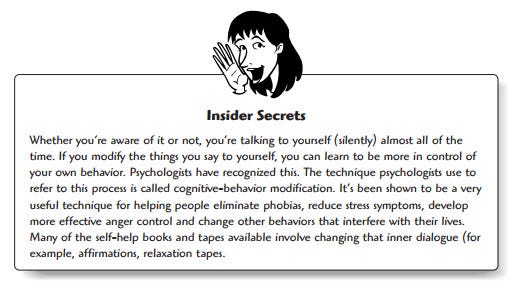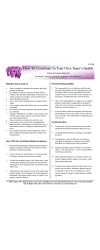Focus on what you CAN control during unpleasant interactions
Self-talk is at the core of staying calm and in control in the face of difficult situations.
Simply put, self-talk refers to the words and thoughts we say to ourselves.
Even if you aren’t aware of the exact words that you’re saying to yourself, be sure that you have this quiet internal process going on within you. It’s a very powerful force for helping you stay calm and changing your own behavior.
We can divide self-talk into two categories:
1. Negative self-talk makes it more difficult to find and use constructive solutions.
2. Positive self-talk is more likely to help you find and use constructive solutions.
Let’s look at them in more detail.

Negative, Nonconstructive Self-Talk
Negative self-talk is inner dialogue that has a tendency to make you more angry, less in control, and less likely to step back and put difficult behavior and situations in context and perspective.
Some general examples of this kind of negative inner dialogue include …
- vilifying or demonizing another person.
- labeling the person in a negative way.
- focusing on how angry you are getting.
- thinking about how unpleasant a conversation with that person is going to be.
- words and thoughts of helplessness.
This kind of self-talk is more likely to make you angrier, more emotional, and less in balance.
To be more specific, what do these statements sound like in your head?
- What an idiot Jane is!
- I wish this person would smarten up.
- Man, he drives me crazy!
- Oh, no, now I have to go talk to Fred.
- Maybe he’ll quit; that’s the only hope.
- This is stupid. I can’t do anything with Herb.
Do these sound familiar? Most people use these at one time or another. Are there ones not listed here that you use? It’s important to identify your own self-talk patterns and habits.
Positive, Constructive Self-Talk
Positive self-talk helps you deal with difficult situations because it relates to problem solving and the possibility of finding solutions and other positive results that you might create.
Some general examples include …
- reminding yourself the other person may have a valid opinion.
- focusing on the possibility of a solution.
- realizing there are two sides, yours and the other person’s.
- looking at problem situations as a challenge rather than something to dread.
Specific examples sound like this:
- Won’t it be neat if I can help turn Fred around?
- I’m sure there’s a solution if only I search for one.
- I have to take special care to stay cool.
- I’m not going to let this person control my life.
If you become more adept at modifying your own self-talk, you will find you can be much more in control. How do you go about changing what you say to yourself?
Well, it’s not easy and takes some diligence and work. First, you have to identify the negative self-talk you use (we all have some). Then you have to decide what self-talk phrases would be better, so you can use them to replace the less constructive ones.
Then, you have to try to catch yourself; when you use a negative self-talk phrase, replace it with a constructive on

e.
Some people benefit from planning out this process. Make a list of your negative self-talk phrases on the left-hand side of a piece of paper. On the right-hand side, write down the more constructive replacements.
If you do this consistently, over time you can succeed at making your internal dialogue more positive. It requires vigilance and a commitment of several months to work on it. That’s because you are trying to learn new mental habits.






